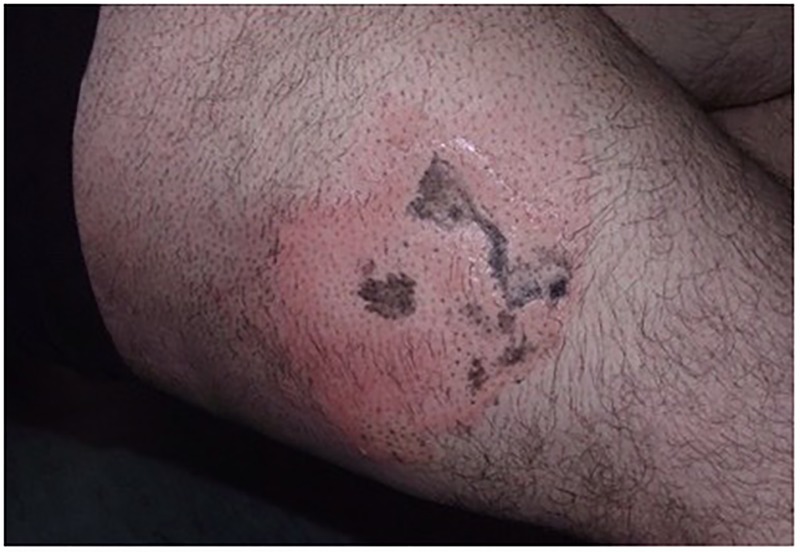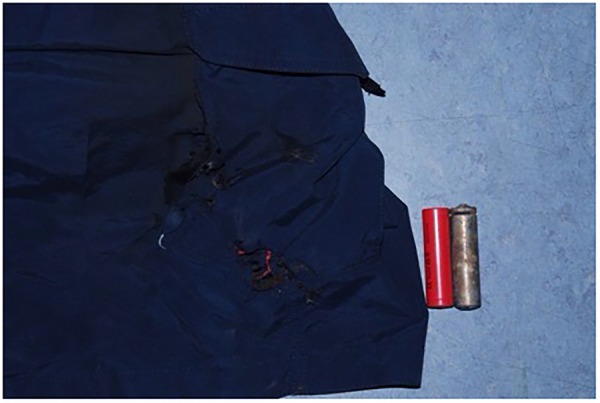Abstract
E-cigarettes have become very popular among adult smokers, and many users carry e-cigarette devices and their components on their person. We present a case of a 35-year-old man who was admitted to our regional burns unit after his clothing was set-alight following the self-combustion of an e-cigarette lithium battery that was in his pocket. The patient had sustained a 1.5% mixed depth burn to the lateral aspect of his right thigh. Ward debridement under local anaesthetic was performed to remove clothing residue and reduce the risk of tattooing. Following conservative management with outpatient dressings, the burn wound healed by day 56.
Background
E-cigarettes (EC) have become very popular among adult smokers in the UK, with 2.1 million estimated current users.1 The rapid diffusion in EC use has led to tension between EC advocates who welcome these products as a means to prevent much of the death and suffering caused by cigarette smoking, and more conventional tobacco control experts who appear to consider ECs primarily as a threat to public health.2
Various media groups in the UK have reported a significant number of residential fires caused by EC devices while charging.3 We have noticed a growing trend of EC users carrying lithium batteries on their person. We present a case of mixed depth burns following spontaneous combustion of an EC lithium battery. Our case report highlights that this new trend poses a small but inherently dangerous fire risk. We describe the mechanism of how lithium batteries combust and advise on safety precautions for EC users.
Case presentation
A 35-year-old man was admitted to our regional burns centre after sustaining a burn to the lateral aspect of his right thigh (figure 1). On obtaining a history, the patient reported that his shorts pocket containing the EC battery and his keys had spontaneously ignited. Following clothing removal, immediate first aid was applied. Emptying of his pocket contents revealed an extensively charred EC battery (figure 2). Further questioning identified that the battery had been charged overnight.
Figure 1.

Close-up of right lateral thigh: predominately superficial partial thickness burn with small mid-dermal areas, interspersed with dye staining from shorts lining.
Figure 2.

Charred battery (far-right), alongside identical undamaged battery, and patient's clothing.
Treatment
Initial assessment identified a mixed depth burn of approximately 1.5% total body surface area. Ward debridement under local anaesthetic was performed to remove clothing residue and reduce the risk of tattooing. The wound was initially dressed using Flamazine cream (1%, Smith and Nephew) and Atrauman (Hartmann). The patient received, in total, three dressing changes consisting of Flamazine+MepilexBorder (Mölnlycke Health Care) then Flamazine+MepilexLite (Mölnlycke Health Care). The wound was healed by day 56 postburn injury. Throughout this patient's care, the wound was dressed with Flamazine (1% silver sulfadiazine) and three different types of dressings: Atrauman (Hartmann), MepilexBorder (Mölnlycke Health Care) and MepilexLite (Mölnlycke Health Care).
Outcome and follow-up
Following conservative management with outpatient dressings, the burn had healed by day 56.
Discussion
Rechargeable lithium batteries are composed of a lithium compound cathode (commonly lithium-cobalt oxide [LiCoO2] or lithium-iron-phosphate [LiFePO4]) and a graphite anode. Lithium ions pass between the cathode and the anode using an intercalated lithium compound.4 5 Rechargeable lithium batteries are inexpensive, have a long battery life and negate the need for continual replacement of new batteries. They are therefore an ideal power source for most electronic devices.
There have been a small number of reports in the literature of lithium batteries self-combusting. These have occurred in a variety of electronic devices such as mobile phones or if the battery has been loosely contained in a pocket with coins or keys.4 6–8 Such cases have resulted in significant morbidity and mortality.
If lithium batteries are either damaged or are in contact with a low-resistance conductor, there is a small risk they may short circuit resulting in a rapid shock discharge of high current. Safety mechanisms within the batteries (cooling vents, separators) have been shown to be ineffective in preventing a rapid shock discharge.6–9 The battery subsequently overheats to temperatures ranging between 100°C and 130°C and may ignite or explode. LiCoO2 compounds are more reactive and have less thermal stability than other compounds used in other types of rechargeable batteries, and are therefore more liable to ignite.3
The patient in our case report had been carrying a fully charged EC lithium battery in a pocket also containing his keys. The keys presumably contacted both battery terminals causing a short circuit and rapid heating, while also acting as resistive heaters themselves. The patient's clothing had subsequently ignited resulting in a mixed depth burn with clothing residue within the wound. This therefore required debridement to prevent tattooing.
The governments of the UK and the USA acknowledge the small but inherently dangerous fire risk of carrying loose lithium batteries on aeroplanes. It is forbidden to carry spare lithium batteries in checked luggage unless they are stored in the device they are to power. Loose batteries are allowed to be carried in carry-on luggage based on the total lithium content of the battery.10 11
We believe burn injuries following combustion of lithium batteries, although rare, are more likely to occur due to the new growing trend of batteries being carried by EC users. Batteries are inherently dangerous to carry and we urge EC users to refrain from carrying loose batteries within their pockets, particularly alongside keys, jewellery and coins. If EC users wish to carry batteries on their person, we suggest that they are stored in a non-conductive, electrically insulated case.
Traumatic tattoos occur as a result from accidental inclusions of intradermal pigmented particles. Best results in preventing skin tattooing are achieved by early removal of the embedded pigmented particles.12 13 We performed surgical debridement of the burn wound using a scrubbing brush, under local anaesthetic. The majority of the debris was superficial and successfully removed using this technique. Other options for removing deeper pigmented particles include dermabrasion, hydrosurgery (eg, Versajet), cryosurgery and Q-switched Nd:YAG lasers.12 14 Small areas of deeper pigments were not successfully removed; however, the patient was satisfied with the clinical outcome and did not wish for further surgical intervention.
Throughout this patient's care, the wound was dressed with Flamazine (1% silver sulfadiazine) and three different types of dressings: Atrauman (Hartmann), MepilexBorder (Mölnlycke Health Care) and MepilexLite (Mölnlycke Health Care). An ideal burn wound dressing does not adhere to the burn wound, does not cause pain on application or removal, controls bacterial colonisation, controls wound exudate, enables movement and reduces the requirement for further dressing changes.15
The characteristics of the dressings we used were ideal for this particular burn based on outpatient assessments.16–18 Flamazine has antimicrobial properties against aerobic and anaerobic pathogens, and therefore limits bacterial colonisation. Its application is not painful in comparison to other antimicrobial crèmes/solutions, for example, mefanide acetate.16 MepilexBorder (Mölnlycke Health Care) and MepilexLite (Mölnlycke Health Care) incorporate a soft foam that absorbs low volumes of exudate.17 18 Both Mepilex dressings were ideal as they absorbed small volumes of exudate and conformed to the curvature surface of the leg. In our experience, there is minimal pain and trauma to the wound on removal at each dressing change. MepilexLite was replaced with MepilexBorder owing to patient and nursing preference. MepilexBorder seals the dressing to surrounding unburned skin, so secondary dressings were no longer required in comparison to MepilexLite.17 18
The rare but potential fire hazards posed by EC must be offset against the well-recognised risks associated with conventional cigarettes, an important cause of accidental fires worldwide. Also taking into account the more traditional health benefits, the growth of EC use is likely to continue. We simply advise caution, particularly with respect to the transport of EC and their potentially combustible lithium batteries.
Learning points.
There is a growing trend in patients carrying e-cigarette devices on their person. E-cigarette (or indeed any other device) batteries should be carried in non-conductive, electrically insulated protective cases. At the bare minimum, batteries should not be carried with other metal objects such as keys as this may precipitate short circuit and ignition.
The burn injuries from portable batteries are caused by setting clothes alight, which must be removed immediately followed by the appropriate first aid.
Clothing involved in flame burns can become embedded into the skin and skin tattooing can occur. In order to prevent this, early removal/excision of embedded particles is advised.
Footnotes
Contributors: ZS collected patient information; KJ was responsible for medical illustration; NK reviewed the article.
Competing interests: None declared.
Patient consent: Obtained.
Provenance and peer review: Not commissioned; externally peer reviewed.
References
- 1.ASH (Action on Smoking and Health). Electronic cigarettes 2014. London: ASH; http://ash.org.uk/files/documents/ASH_715.pdf [Google Scholar]
- 2.West R, Brown J. Electronic cigarettes: fact and faction. Br J Gen Pract 2014;64:442–3. 10.3399/bjgp14X681253 [DOI] [PMC free article] [PubMed] [Google Scholar]
- 3.Calls for safety warning after ‘exploding’ e-cigarette chargers cause more than 100 fires. The Independent Newspaper. http://www.independent.co.uk/news/uk/home-news/calls-for-safety-warnings-after-exploding-ecigarette-chargers-cause-more-than-100-fires-9862857.html (accessed 12 Feb 2015).
- 4.Doughty D, Roth EP. A general discussion of Li Battery Safety. The Electrochemical Society. Summer 2012:33–44.
- 5.Manickam M, Takata M. Lithium intercalation cells LiMnO2/LiTi2O2 without metallic lithium. J Power Sources 2003;114:298–302. 10.1016/S0378-7753(02)00586-4 [DOI] [Google Scholar]
- 6.Rose A, Zahid H, Falder S. Lithium-ion battery: the “mini-bomb” in your pocket, on your desk, and behind your wheels! J Burn Care Res 2010;31:675 10.1097/BCR.0b013e3181e4c5a3 [DOI] [PubMed] [Google Scholar]
- 7.Ben D, Ma B, Liu L et al. . Unusual burns with combined injuries caused by mobile phone explosion: watch out for the “mini-bomb”! J Burn Care Res 2009;30:1048.. 10.1097/BCR.0b013e3181bfb8c0 [DOI] [PubMed] [Google Scholar]
- 8.Mores S, Ottoway M. Evaluation on safety performance of lithium ion battery by accelerating rate calorimeter. Chin J Power Sources 2007;31:19–22. [Google Scholar]
- 9.Khundkar R, Malic C, Estela C. Burned by a battery-coin short circuit: old concept for a new burn. Burns 2010;36:e4–5. 10.1016/j.burns.2008.11.018 [DOI] [PubMed] [Google Scholar]
- 10.“Traveling Safe with Batteries.” U.S. Department of Transportation. http://phmsa.dot.gov/safetravel/batteries. Retrieved 12 Feb 2015.
- 11.“British Airway's Policy on Lithium Batteries”. British Airways. PDF Document. https://www.britishairways.com/cms/global/pdfs/Forbidden_Items_List.pdf (accessed 7 Feb 2016).
- 12.Siemers F, Stang FH, Namdar T et al. . Removal of accidental inclusions following blast injury by use of hydrosurgery system (VersajetTM). Inj Extra 2010;41:83–4. 10.1016/j.injury.2010.05.012 [DOI] [Google Scholar]
- 13.Baruchin AM, Schaf S. Care of traumatic tattoos associated with gunpowder explosions and blast burns. In: Masellis M, Gunn SWA, eds. The management of mass burn casualties and fire disasters. Springer, 1992:292–5. [Google Scholar]
- 14.Ebrahimi A, Kalantar Motamedi MH. Application of silver sulfadiazine cream with early surgical intervention in patients suffering from combined burn-blast injury facial tattoos. Trauma Mon 2012;17:255–8. 10.5812/traumamon.3935 [DOI] [PMC free article] [PubMed] [Google Scholar]
- 15.Rowley-Conwy G. Management of minor burns in the emergency department. Nurs Stand 2012;26:60, 62, 64–7 10.7748/ns2012.02.26.24.60.c8948 [DOI] [PubMed] [Google Scholar]
- 16.Gallagher JL, Branski LK, Bouyer NW et al. . Treatment of infection in burns. In: Herndon DN, ed. Total burn care. London: Saunders Co, 2007:421–31, 137–56. [Google Scholar]
- 17.Mepilex Border. Mölnlycke Health Care. http://www.molnlycke.co.uk/advanced-wound-care-products/foam-dressings/mepilex-border/. Retrieved 17 November 2015.
- 18.Mepilex Lite. Mölnlycke Health Care. http://www.molnlycke.co.uk/advanced-wound-care-products/foam-dressings/mepilex-lite/. Retrieved 17 November 2015.


